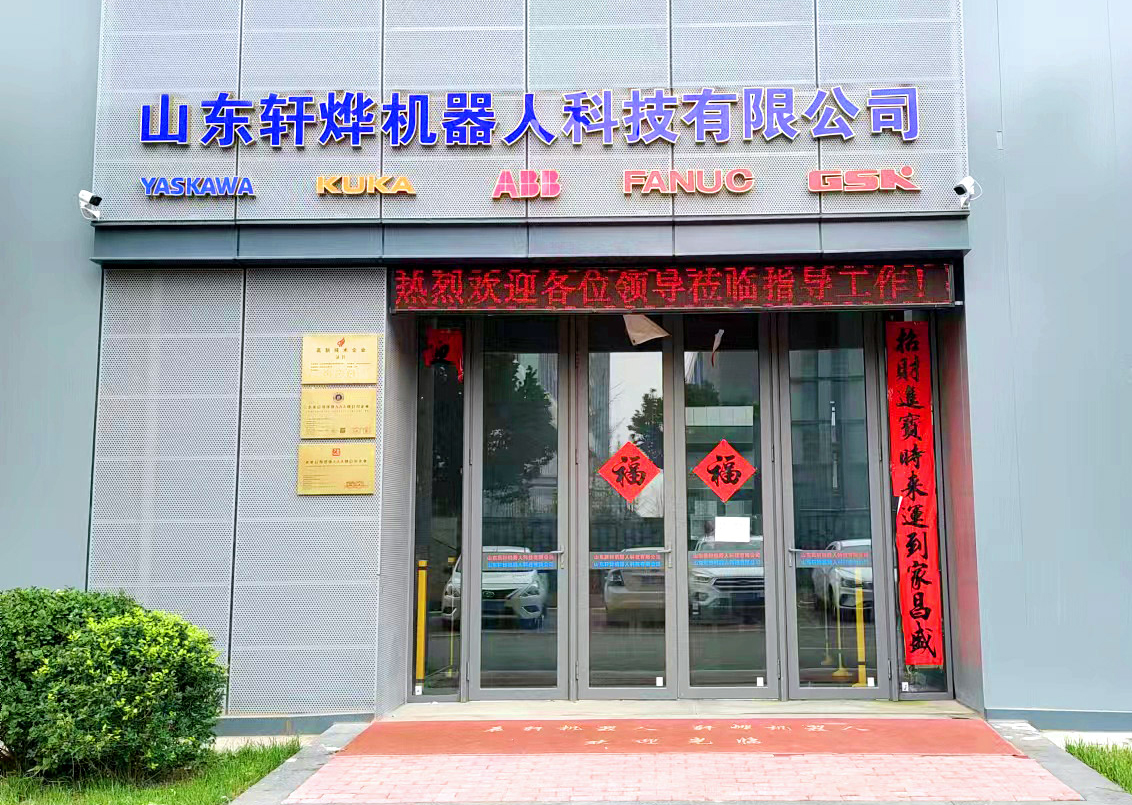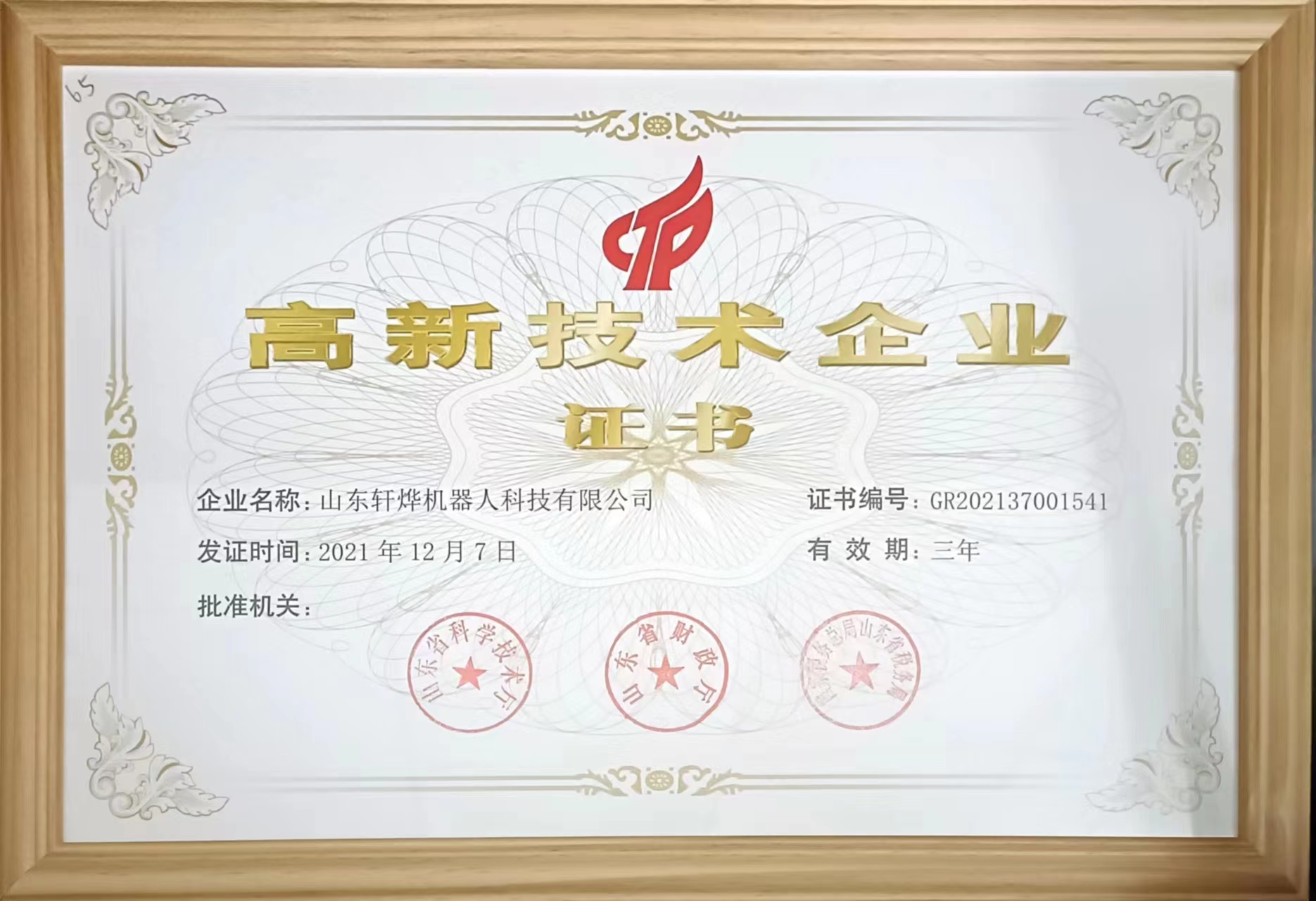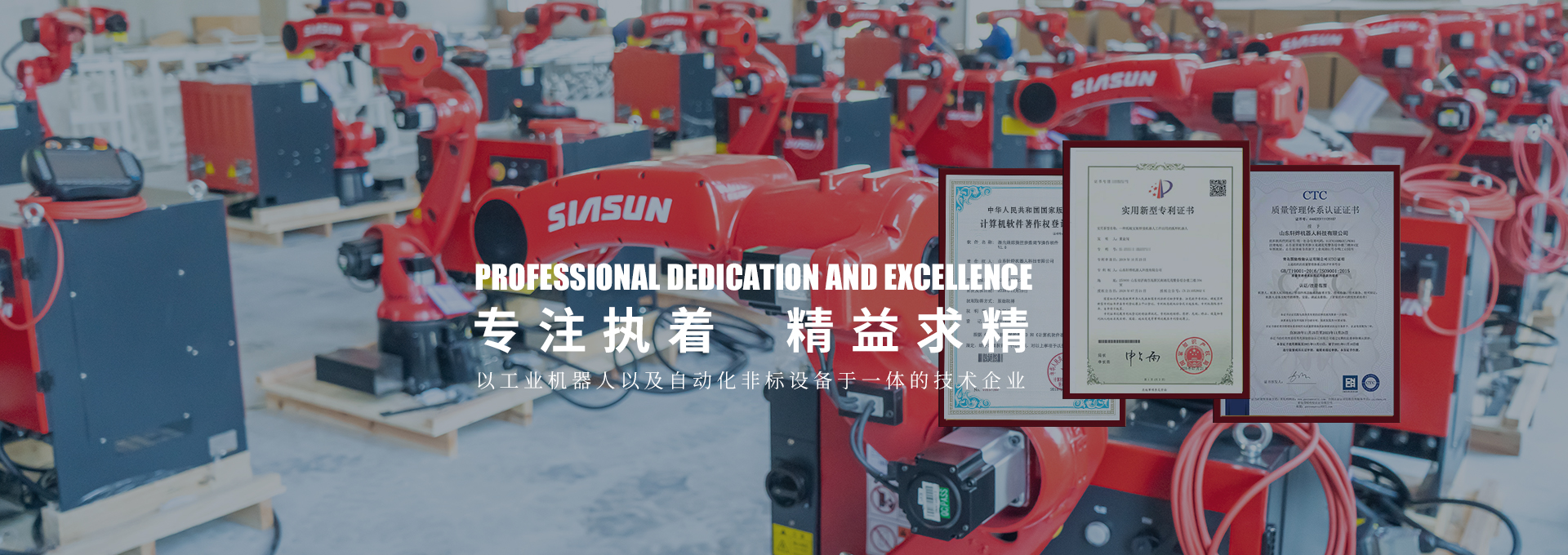
山东轩烨机器人科技有限公司是一家以工业机器人以及自动化非标设备于一体的技术企业,公司致力于焊接、切割、机器人机床上下料等领域的机器人智能化研究和产业化应用

公司立足于高端装备制造等战略新兴产业,将追逐“制造2025"致力于机器人技术和互联网技术的深度融合,推动智造。
发布:2024-01-13 浏览:0
工业机器人是面向工业领域的多关节机械手或多自由度的机器装置,具有柔性好、自动化程度高、可编程性好、通用性强等特点。在工业领域中,工业机器人的应用能够代替人进行单调重复的生产作业,或是在危险恶劣环境中的加工操作。国际上,工业机器人的定义主要有如下两种:
Industrial robots are multi joint robotic arms or multi degree of freedom machine devices designed for the industrial field, characterized by good flexibility, high automation, good programmability, and strong versatility. In the industrial field, the application of industrial robots can replace humans in monotonous and repetitive production operations or processing operations in dangerous and harsh environments. Internationally, there are two main definitions of industrial robots:
标准化组织(ISO)的定义:工业机器人是一种具有自动控制的操作和移动功能,能完成各种作业的可编程操作机。
The definition of the Organization for Standardization (ISO) is that industrial robots are programmable operating machines with automatic control and movement functions, capable of completing various tasks.
机器人协会(RIA)的定义:一种可以反复编程和多功能的,用来搬运材料、零件、工具的操作机;或者为了执行不同的任务而具有可改变的和可编程的动作的专门系统。
The definition of the Robotics Association (RIA) is a machine that can be repeatedly programmed and multifunctional for handling materials, parts, and tools; Or a specialized system with adjustable and programmable actions to perform different tasks.
在智能制造领域,工业机器人作为一种集多种技术于一体的自动化装备,体现了现代工业技术的益、软硬件结合等特点,成为柔性制造系统、自动化工厂、智能工厂等现代化制造系统的重要组成部分。机器人技术的应用转变了传统的机械制造模式,提高了制造生产效率,为机械制造业的智能化发展提供了技术保障;优化了制造工艺流程,能够构建全自动智能生产线,为制造模块化作业生产提供了良好的环境条件,满足现代制造业的生产需要和发展需求。
In the field of intelligent manufacturing, industrial robots, as an automation equipment that integrates multiple advanced technologies, reflect the high efficiency and combination of software and hardware of modern industrial technology, and have become an important component of modern manufacturing systems such as flexible manufacturing systems, automated factories, and intelligent factories. The application of robot technology has transformed the traditional mechanical manufacturing mode, improved manufacturing production efficiency, and provided technical support for the intelligent development of the mechanical manufacturing industry; The manufacturing process has been optimized, enabling the construction of fully automated intelligent production lines, providing favorable environmental conditions for modular production and meeting the production and development needs of modern manufacturing.
在智能制造领域,多关节工业机器人、并联机器人、移动机器人的本体开发及批量生产,使得机器人技术在焊接、搬运、喷涂、加工、装配、检测、清洁生产等领域得到规模化集成应用,极大地提高了生产效率和产品质量,降低了生产和劳动力成本。

In the field of intelligent manufacturing, the development and mass production of multi joint industrial robots, parallel robots, and mobile robots have enabled the large-scale integrated application of robot technology in welding, handling, spraying, processing, assembly, testing, clean production, and other fields, greatly improving production efficiency and product quality, and reducing production and labor costs.
1)焊接机器人
1) Welding robot
在汽车、工程机械、船舶、农机等行业,焊接机器人的应用十分普遍。作为精细度需求较高、工作环境质量较差的生产步骤,焊接的劳动强度极大,对焊接工作人员的素养要求较高。由于机器人具备抗疲劳、高精准、抗干扰等特点,应用焊接机器人技术取代人工焊接,可保证焊接质量一致性,提高焊接作业效率,同时也能直观地反馈焊接作业的质量。
Welding robots are widely used in industries such as automobiles, construction machinery, ships, and agricultural machinery. As a production step with high precision requirements and poor working environment quality, welding has a high labor intensity and requires high professional competence from welding workers. Due to the characteristics of fatigue resistance, high precision, and anti-interference of robots, the application of welding robot technology to replace manual welding can ensure consistency in welding quality, improve welding efficiency, and also provide intuitive feedback on the quality of welding operations.
目前,投放于焊接岗位的机器人的种类较多,根据使用场合的差异,选用的焊接机器人种类各有不同,其中多关节机器人的应用较为普遍,如图7所示。结合多关节机器人的运动灵活、空间自由度较高的特点,能够调整任意的焊接位置和姿态,有效地提升了制造中的生产效率与生产质量。
At present, there are many types of robots used in welding positions, and the types of welding robots selected vary depending on the usage situation. Among them, multi joint robots are more commonly used, as shown in Figure 7. Combining the flexible movement and high spatial freedom of multi joint robots, they can adjust any welding position and posture, effectively improving production efficiency and quality in manufacturing.
2)搬运机器人
2) Transport robot
机器人技术同样能够应用到制造业的搬运作业中。借助人工程序的构架与编排,将搬运机器人投放入当今制造业生产之中,从而实现运输、存储、包装等一系列工作的自动化进行,不仅有效地解放了劳动力,而且提高了搬运工作的实际效率。通过安装不同功能的执行器,搬运机器人能够适应各类自动生产线的搬运任务,实现多形状或不规则的物料搬运作业。同时考虑到化工原料及成品的危险性,利用搬运机器人进行运输能降低隐患,减小危险品及辐射品对搬运人员的人体伤害。
Robot technology can also be applied to handling operations in the manufacturing industry. By utilizing the architecture and arrangement of manual programs, the handling robots are integrated into today's manufacturing production, achieving automation in a series of tasks such as transportation, storage, and packaging. This not only effectively liberates labor, but also improves the actual efficiency of handling work. By installing actuators with different functions, the handling robot can adapt to various automatic production line handling tasks and achieve multi shaped or irregular material handling operations. At the same time, considering the danger of chemical raw materials and finished products, using handling robots for transportation can reduce safety hazards and minimize the harm of hazardous and radiation materials to the human body of handling personnel.
目前,固定式串联搬运机器人在制造业中应用广泛,其优点是工作空间大、结构简单,但其负载较低、刚性较差,只能在固定工位上完成简单的搬运工作,具有一定的局限性。通过结合移动机器人技术和并联机器人技术,能有效地提高搬运机器人的承载能力和作业范围,在汽车、物流、食品、医药等行业具有广阔的应用前景。
At present, fixed series handling robots are widely used in the manufacturing industry. Their advantages are large workspace and simple structure, but their load is low and rigidity is poor. They can only complete simple handling work on fixed workstations, which has certain limitations. By combining mobile robot technology and parallel robot technology, the carrying capacity and operating range of the handling robot can be effectively improved, and it has broad application prospects in industries such as automobiles, logistics, food, and medicine.
3)加工机器人
3) Processing robots
随着生产制造向着智能化和信息化发展,机器人技术越来越多地应用到制造加工的打磨、抛光、钻削、铣削、钻孔等工序当中。与进行加工作业的工人相比,加工机器人对工作环境的要求相对较低,具备持续加工的能力,同时加工产品质量稳定、生产效率高,能够加工多种材料类型的工件,如铝、不锈钢、铜、复合材料、树脂、木材和玻璃等,有能力完成各类高精度、大批量、高难度的复杂加工任务。
With the development of intelligent and information-based production and manufacturing, robot technology is increasingly being applied to processes such as polishing, drilling, milling, and drilling in manufacturing. Compared with workers performing processing tasks, processing robots have relatively lower requirements for the working environment, possess the ability to continuously process, and have stable product quality and high production efficiency. They can process various types of workpieces, such as aluminum, stainless steel, copper, composite materials, resin, wood, and glass, and have the ability to complete various high-precision, large-scale, and difficult complex processing tasks.
相比机床加工,工业机器人的缺点在于其自身的弱刚性。但是加工机器人具有较大的工作空间、较高的灵活性和较低的制造成本,对于小批量多品种工件的定制化加工,机器人在灵活性和成本方面显示出较大优势;同时,机器人更加适合与传感器技术、人工智能技术相结合,在航空、汽车、木制品、塑料制品、食品等领域具有广阔的应用前景,
Compared to machine tool processing, the disadvantage of industrial robots is their weak rigidity. However, processing robots have a larger workspace, higher flexibility, and lower manufacturing costs. For customized processing of small batch and multi variety workpieces, robots show significant advantages in flexibility and cost; Meanwhile, robots are more suitable for combining with sensor technology and artificial intelligence technology, and have broad application prospects in fields such as aviation, automobiles, wood products, plastic products, and food,

截屏,微信识别二维码